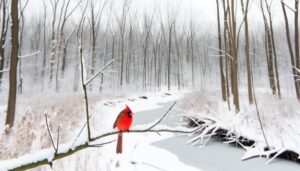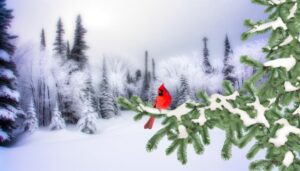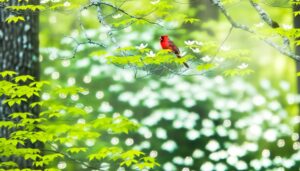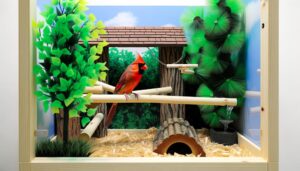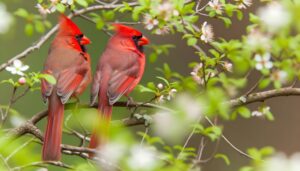How Do Northern Cardinals Nest in Your Bird House?
Northern Cardinals don't typically nest in birdhouses. They prefer dense shrubs and low tree branches, which provide security and ease of access.
Females build nests from twigs and leaves, selecting sites 1 to 15 feet above ground. Cardinals favor natural habitats with abundant foliage for concealment and foraging.
Although they might occasionally use large, well-ventilated birdhouses, their nesting success is highest in complex habitats with natural cover. Proper placement of birdhouses in shaded, secluded areas can increase the likelihood of occupation.
To fully understand these birds' nesting preferences and behavior, explore additional details about their natural habitat choices.

Key Takeaways
- Cardinals rarely use traditional birdhouses, preferring open nesting sites in dense shrubs or low trees.
- They favor natural habitats with abundant foliage for concealment and nesting.
- Proper birdhouse placement in shrubby, secluded areas can increase occupation likelihood.
- Birdhouses made from natural, untreated wood with good ventilation may attract cardinals.
- Cardinals thrive in habitats with ample food sources and cover, essential for their nesting success.
Northern Cardinals' Nesting Habits
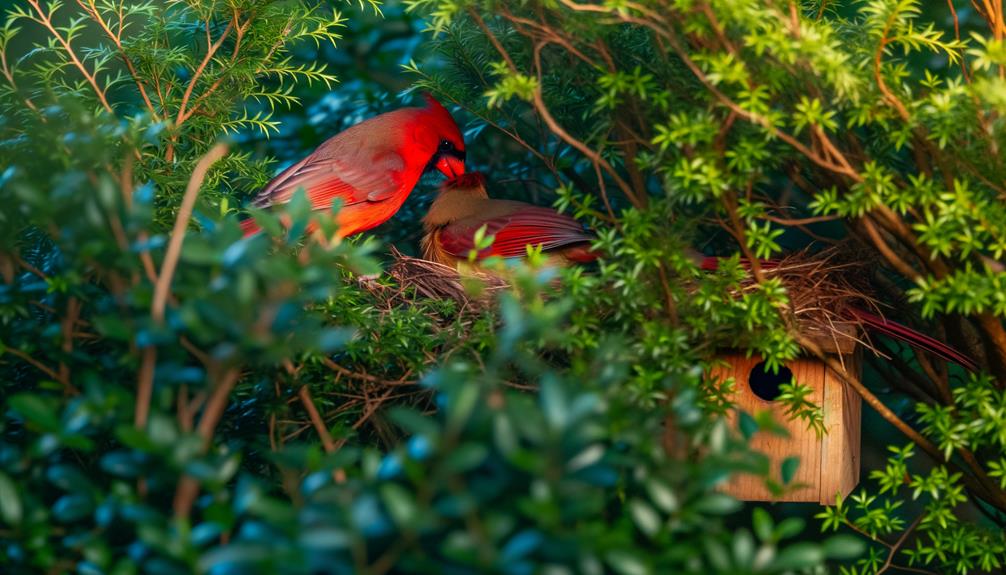
Northern Cardinals frequently exhibit a preference for nesting in dense shrubs or low tree branches, favoring these locations for their protective cover and ease of access. Studies have shown that such environments provide ideal shelter from predators and harsh weather conditions. Cardinals typically select sites that are 1 to 15 feet above ground, ensuring a balance between security and accessibility.
They construct their nests using a combination of twigs, leaves, and grasses, creating a sturdy yet camouflaged structure. Females primarily undertake nest-building, meticulously weaving materials to form a cup-like shape. This behavior underscores their adaptability to varying habitats, although they distinctly avoid open, exposed areas, reflecting a pronounced inclination towards seclusion and safety in their nesting habits.
Ideal Nesting Locations
Northern Cardinals show a preference for nesting in dense shrubbery. This offers protection from predators and harsh weather. Studies indicate that they also choose tree branches at moderate heights. This ensures a balance between accessibility and safety.
Their selection of natural habitats often includes areas with abundant foliage. This provides both concealment and a reliable food source.
Dense Shrubbery Preference
Research indicates that cardinal pairs show a marked preference for nesting in dense shrubbery, where they find the most suitable cover and protection from predators. This type of vegetation provides a labyrinthine structure that obscures nests from view and deters potential threats. Dense shrubbery also stabilizes microclimates, ensuring ideal conditions for egg incubation and chick development. Studies have shown that cardinals frequently select sites with specific characteristics, as outlined below:
| Shrub Type | Nesting Height (ft) | Nest Density (nests/acre) |
|---|---|---|
| Evergreen | 4-7 | 15 |
| Deciduous | 3-6 | 10 |
| Mixed Vegetation | 5-8 | 12 |
This data underscores the importance of plant variety and structure in cardinal nesting behavior, highlighting their adaptability and ecological requirements.
Tree Branch Choices
Cardinals frequently select tree branches that provide a combination of height, stability, and concealment for their nests. Research indicates they prefer branches located 3-15 feet above ground, ensuring safety from ground predators.
Stability is pivotal; cardinals often choose robust branches capable of supporting the nest's weight. Concealment is another key factor, as dense foliage offers protection from aerial predators and harsh weather.
Studies have shown that cardinals exhibit a preference for deciduous trees, such as dogwoods and maples, which provide ample cover during nesting season. Additionally, the branching structure of these trees enhances the nest's security, reducing the likelihood of displacement.
This selective branch choice underscores the cardinal's adaptive strategies for optimizing reproductive success.
Natural Habitat Selection
Many bird species, including the Northern Cardinal, display a marked preference for nesting in environments that offer a blend of dense vegetation, reliable food sources, and minimal human disturbance. Cardinals typically select nesting sites in shrubs, small trees, and thickets, where foliage provides concealment from predators.
Studies indicate that these birds favor habitats with abundant berry-producing plants and seed-bearing flora, ensuring consistent food availability. Additionally, proximity to water sources, such as streams or ponds, is advantageous.
Cardinals rarely utilize bird houses, as these artificial structures often lack the necessary cover and natural resources. Research underscores that their nesting success correlates strongly with habitat complexity and plant diversity, which offer essential protection and sustenance.
Natural Nest Preferences
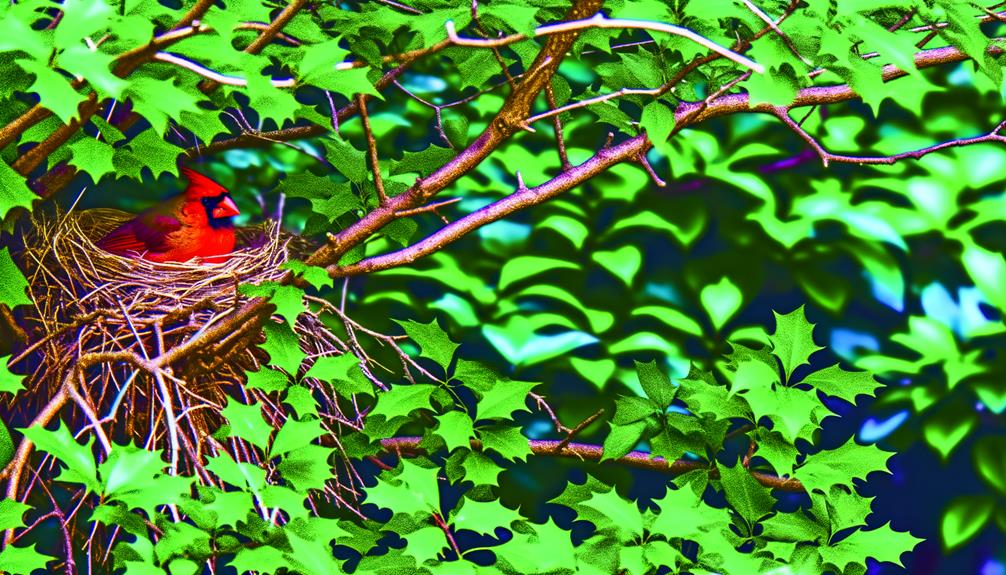
In their natural habitat, Northern Cardinals exhibit a strong preference for nesting in dense bushes or thickets, where they can find best refuge and concealment. These birds typically select sites that provide best protection from predators and harsh weather conditions.
Studies indicate they favor deciduous trees and shrubs, often placing nests 1-15 feet above ground. Preferred vegetation includes dogwood, honeysuckle, and rose bushes, which offer dense foliage. Cardinals construct their nests using twigs, bark strips, and grasses, layering them meticulously to ensure structural stability.
The chosen location's density not only conceals the nest but also aids in temperature regulation, essential for egg incubation. This natural preference highlights their specific habitat requirements and the significance of suitable nesting environments for their reproductive success.
Types of Birdhouses
Understanding the types of birdhouses suitable for Northern Cardinals involves evaluating materials and construction. Cardinals prefer birdhouses made from natural wood due to its insulating properties. Best dimensions and strategic placement greatly influence nesting success rates.
Research indicates that size and dimensions play a crucial role in attracting Northern Cardinals to birdhouses. Additionally, the location and placement of the birdhouse are significant factors to consider.
Materials and Construction
Selecting the appropriate materials for constructing birdhouses is vital to guarantee the safety and comfort of Northern Cardinals.
Research indicates that untreated wood, like cedar or pine, offers ideal insulation and durability, necessary for maintaining a stable microclimate within the birdhouse. Moreover, using galvanized screws or nails prevents rust and structural degradation. Avoiding toxic paints and finishes is essential, as Northern Cardinals are sensitive to harmful chemicals.
Proper ventilation and drainage holes, constructed from non-corrosive materials, ensure a dry and breathable environment, reducing the risk of mold and mildew. Additionally, incorporating predator guards made from metal can deter potential threats, thereby increasing the likelihood of successful nesting.
Size and Dimensions
Proper size and dimensions of birdhouses are essential for accommodating Northern Cardinals, ensuring adequate space for nesting and raising their young. Evidence suggests that a birdhouse with a floor area of approximately 6×6 inches and a height of 8-10 inches provides ideal space.
The entrance hole should be around 1.5 inches in diameter, slightly above the floor level, to facilitate easy access while keeping predators at bay. Ventilation holes and drainage are critical to maintain a healthy nesting environment.
Scientific observations indicate that these dimensions support Northern Cardinals' nesting behaviors, promoting successful reproduction. By adhering to these specifications, individuals can create conducive nesting spaces, enhancing the likelihood of attracting these vibrant birds to their gardens.
Location and Placement
Placing birdhouses in strategic locations is essential for attracting Northern Cardinals, as evidence indicates that these birds prefer secluded, shaded areas with ample cover. Research shows that Northern Cardinals typically avoid open spaces and areas with high human activity. They're more likely to nest in areas that provide a sense of security and protection from predators.
Proper placement involves considering several key factors:
- Height: Position birdhouses 5 to 15 feet off the ground to deter predators.
- Orientation: Face the entrance away from prevailing winds to ensure comfort.
- Vegetation: Surround birdhouses with dense shrubs or trees for additional cover.
- Water Source: Place near a water source to meet the cardinals' hydration needs.
Implementing these guidelines maximizes the likelihood of successful nesting.
Cardinals and Birdhouses
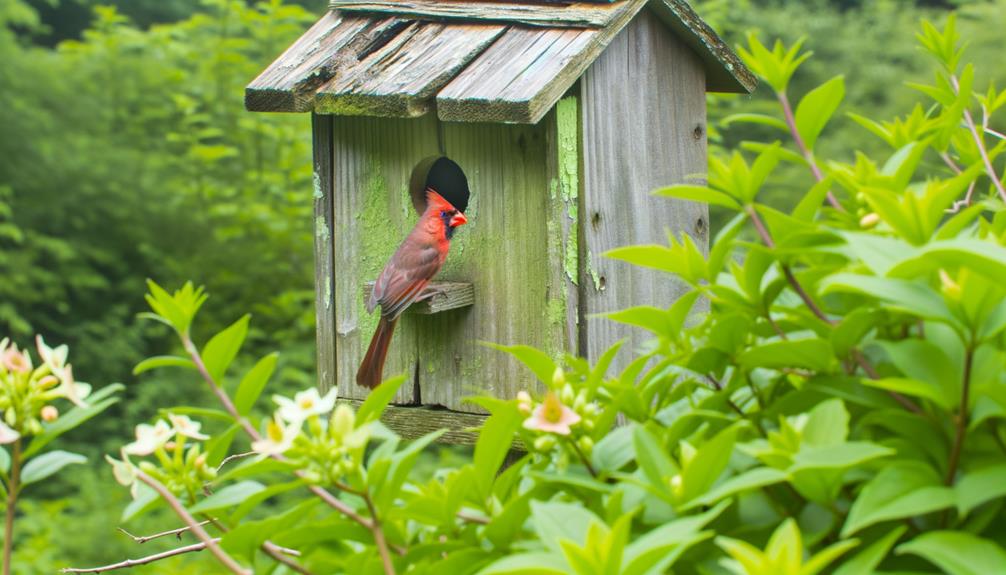
Cardinals often face challenges when adapting to birdhouses due to their specific nesting preferences and habitat requirements. Unlike cavity-nesting birds, cardinals prefer open nesting sites in dense shrubs or low trees. Studies show that cardinals rarely use traditional birdhouses, as these structures don't align with their natural nesting behavior.
They thrive in habitats that provide ample cover and concealment, essential for protecting their nests from predators. Additionally, cardinals exhibit strong territorial instincts, favoring nesting sites that offer a clear field of vision. Evidence indicates that their nesting success correlates with the availability of dense foliage and shelter.
Consequently, while cardinals can occasionally be found using open platform feeders, birdhouses are generally unsuitable for their nesting needs.
Birdhouse Size and Design
When designing birdhouses, understanding the specific size and structural details that accommodate different bird species is essential for optimizing their use and success.
Northern Cardinals typically prefer open nesting sites and are less inclined to use enclosed birdhouses. However, certain design elements can still attract them:
- Entrance Hole Size: Although cardinals usually avoid enclosed spaces, a birdhouse with a large entrance (3-4 inches) may be more inviting.
- Interior Dimensions: A spacious interior, approximately 8×8 inches, can provide ample room.
- Ventilation: Sufficient air circulation is vital for maintaining a healthy environment.
- Materials: Natural, untreated wood helps mimic their preferred natural habitats.
Placement of Birdhouses
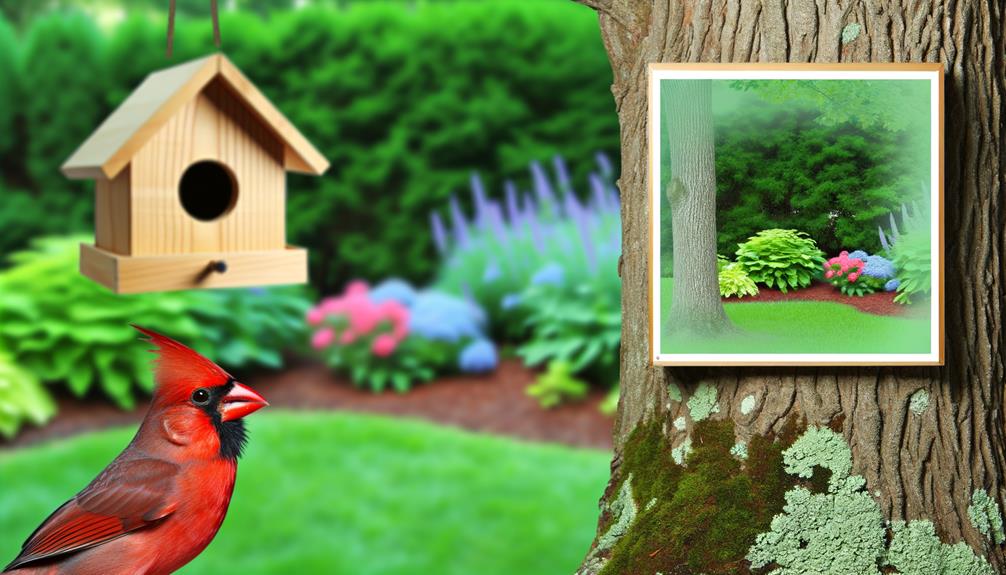
Proper placement of birdhouses is important for encouraging Northern Cardinals to view these structures as potential nesting sites. Cardinals prefer dense, shrubby areas with ample cover to protect against predators.
Studies indicate placing birdhouses 4-6 feet off the ground, within proximity of dense foliage, increases the likelihood of occupation. Orientation matters too; facing the entrance away from prevailing winds minimizes exposure to harsh weather conditions, creating a more stable environment.
Additionally, keeping birdhouses spaced apart reduces territorial conflicts. While cardinals typically prefer natural nesting sites, providing a well-placed birdhouse in a suitable habitat can offer an alternative.
Understanding these placement criteria can greatly enhance the chances of attracting cardinals to utilize birdhouses for nesting purposes.
Attracting Cardinals
To effectively attract Northern Cardinals, one must consider providing a reliable food source, such as sunflower seeds, which are known to be highly favored by these birds.
Creating a cardinal-friendly environment involves several key strategies supported by evidence.
- Thick Foliage: Cardinals prefer habitats with thick foliage or dense bushes, offering both cover and nesting opportunities.
- Tree Choices: Trees like dogwood, mulberry, and sumac provide natural food sources and suitable nesting sites.
- Consistent Food Provision: Maintaining a steady supply of sunflower seeds can greatly increase the likelihood of attracting cardinals.
- Secure Environment: Minimizing disturbances from predators and human activity ensures a secure haven for these birds.
Providing Food and Water
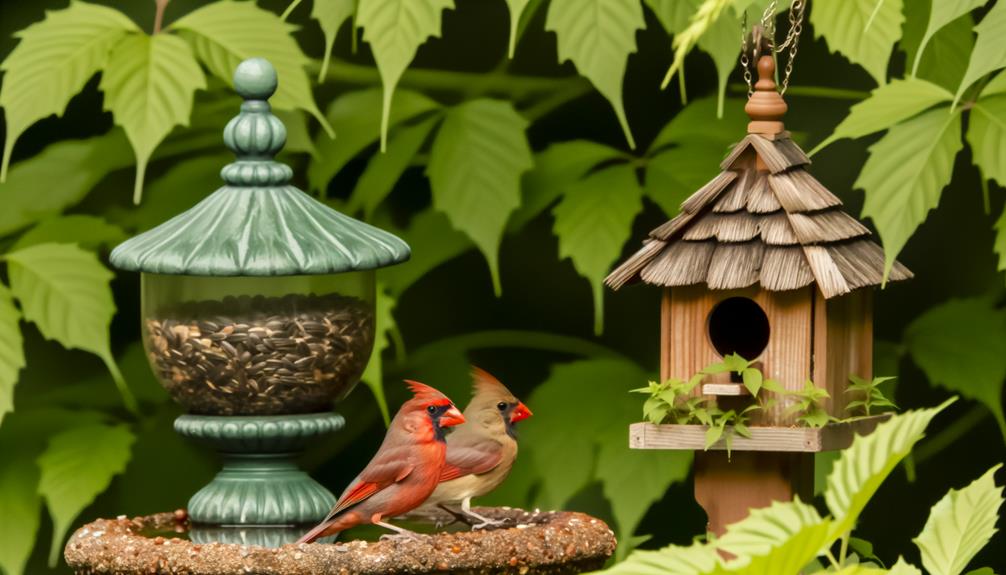
Ensuring the availability of nutritious seeds is important, as Northern Cardinals primarily feed on sunflower seeds, safflower seeds, and cracked corn.
Providing a consistent source of fresh water is equally vital, with studies indicating that reliable water sources notably increase bird visitation rates.
Implementing these measures can significantly improve the likelihood of cardinals nesting in bird houses.
Offering Nutritious Seeds
Offering Northern Cardinals a range of nutritious seeds guarantees they receive essential nutrients for peak health and successful nesting. Scientific studies indicate that a varied seed diet strengthens their immune system and promotes vibrant plumage.
To effectively provide these crucial nutrients, consider the following:
- Sunflower Seeds: High in fat, these seeds offer energy crucial during breeding seasons.
- Safflower Seeds: Rich in protein, they support muscle development and feather growth.
- Millet: This small seed is easily digestible and supports overall metabolism.
- Peanuts (shelled and unsalted): Provide essential amino acids and healthy fats.
Ensuring Fresh Water
Providing Northern Cardinals with a steady supply of fresh water is equally important as offering nutritious seeds, as hydration plays a pivotal role in their overall health and successful nesting. Water sources should be clean, shallow, and placed in safe, predator-free zones. Studies indicate that well-hydrated birds exhibit better thermoregulation, enhanced metabolic functions, and higher reproductive success. Birdbaths, drippers, and misters are excellent options, particularly during dry seasons. Regularly changing the water prevents bacterial growth, ensuring a healthy environment.
| Water Source | Benefits | Maintenance Frequency |
|---|---|---|
| Birdbath | Easy access for drinking | Daily |
| Dripper | Stimulates natural behavior | Every few days |
| Mister | Cooling effect | Weekly |
Ensuring both food and water availability supports sustainable cardinal populations.
Creating a Safe Environment
To create a secure environment for Northern Cardinals nesting in bird houses, one must consider factors such as location, predator prevention, and appropriate nesting materials. Evidence suggests that ideal positioning of bird houses can enhance nesting success.
- Location: Place bird houses 5-6 feet above the ground in shaded, secluded areas to reduce stress and exposure.
- Predator Prevention: Use predator guards and baffles to deter snakes, raccoons, and other potential threats.
- Nesting Materials: Provide Cardinals with soft, natural materials like grass, twigs, and leaves to construct their nests.
- Maintenance: Regularly clean and inspect bird houses to ensure they remain secure and free from parasites.
These steps collectively foster a conducive environment, promoting secure and successful nesting for Northern Cardinals.
Observing Cardinal Families
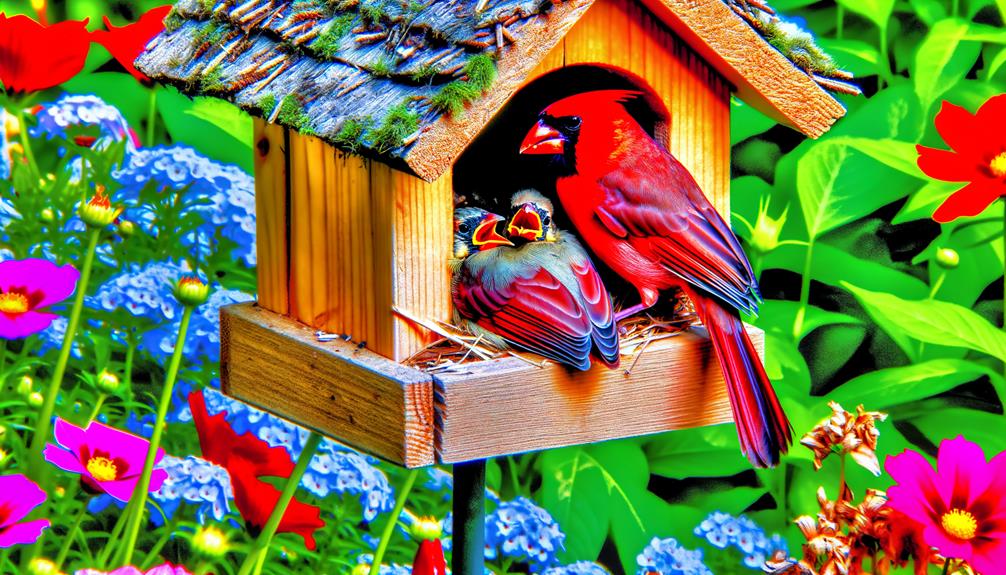
Observing cardinal families requires patience and keen attention to their behaviors and interactions within their natural habitat. Researchers have noted that cardinals exhibit strong family bonds, with both parents actively participating in nest building, feeding, and protecting their young.
They prefer dense shrubbery and tree cover, which provides camouflage and safety from predators. Detailed observations reveal that male cardinals often feed the female during incubation and assist in feeding the fledglings once they hatch. Documenting these activities can offer valuable insights into their mating rituals, parenting strategies, and survival mechanisms.
Conclusion
To sum up, Northern Cardinals typically shun birdhouses, favoring dense shrubs and trees for nesting. Their natural inclination is towards open, cup-shaped nests nestled in thick foliage.
While they rarely use birdhouses, creating an inviting environment by providing food, water, and safe shelter can attract them. Think of your garden as a well-stocked banquet, offering all necessities for a cardinal family.
By understanding and catering to their preferences, one can enjoy observing these vibrant birds up close.

